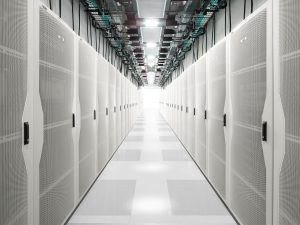You’ve seen the data points: 30 million new devices connected to the Internet each week. A whopping 50 billion connected by 2020. This surge of connectivity – driven largely by the Internet of Everything – is creating vast new opportunities for digitization as industries transform.
This tidal wave of connected devices is also reshaping the data center. Why? Because every single thing connected to the Internet has a MAC and IP address, and this enormous growth will unleash more addresses than anyone can imagine. These addresses need, feed, and breed applications, whether by running an app or providing it data. And as this happens at an exponential scale, the data center becomes the key to making it all work.
We know that the applications will be everywhere, and that’s a good thing. Apps will continue to be in the enterprise data center – the private cloud—where they’ve been running for a long time. And they’ll run in cloud-based data centers. They’ll also run at the edge – whether the edge is a branch office, your home, or even a part of your body.
For applications to perform optimally no matter where they are, the infrastructure has to understand the language of applications. We have to teach it. And this is where policy comes in. For us, policy is teaching the infrastructure the language of the application so that the application can tell the infrastructure, “Here is what I need to run at my best.”
This is an area where Cisco has a lot of skin in the game. After all, no one knows Data Center infrastructure better than we do.
Our Application Centric Infrastructure (ACI) is an example of policy. It’s our flagship offering, our strategic direction. And it’s vertically integrated – spanning hardware and software. It’s also really popular. Just last week, we reached our 1000th customer – Danske Bank, the largest financial institution in Denmark.
Why is the network the best place to put policy?
First, the network touches everything – from the data center to the cloud to every device. Just as the applications are everywhere, so is the network as the foundation. And when you’re trying to set policy, you’ve got to get it out and make it available to everything on the network.
Another reason: the network is the single source of truth within the infrastructure. It knows every conversation that’s happening between every device. It knows who’s communicating a lot and who isn’t, or who’s communicating a little bit of the time but in big chunks. The network never lies.
Why Cisco
Moving addresses, frames and packets is our core competency. Believe me when I tell you — if our development team could stick a chicken-salad sandwich inside an Ethernet frame, they would do it. It’s what we have done a lot of here at Cisco – get things on the network.
Where are we going from here? With the vast scale we’re looking at – once 50 billion or more devices are connected – it won’t be possible for any single human, or any one programming tool, or any one piece of software to manage or optimize this network.
The infrastructure itself is going to have to learn and be self-aware to scale. This explains why we’ve begun exploring how to get all this needed policy and expertise into the silicon and into the infrastructure.
When I envision the data center of the future, I see a data center that has unprecedented scale and always-on network analytics, one that creates a dynamic and agile infrastructure, that is self-learning, self-healing and self-executing, and that drives business outcomes faster than any human ever could. This is where we’re going, and why I’m so damned excited about it.
Stay tuned. There’s a lot more to come.



that is self-learning, self-healing and self-executing, and that drives business outcomes faster than any human ever could. This is where we’re going, and why I’m so damned excited about it.
This explains why we’ve begun exploring how to get all this needed policy and expertise into the silicon and into the infrastructure
nice article
業界最高峰のブランドコピー 激安、コピーブランド、スーパーコピーブランド(N級品)通販専門店!ブランドコピー,コピーブランド,スーパーコピーブランド,ブランドコピー 激安,偽物ブランド、偽物のバッグ、腕時計、財布など激安で買える!全部のスーパーコピー販売品物のなかで私達のブランド激安が一番有名です http://www.msnbrand.com/brand-copy-IP-3.html
2015ブランド財布コピールイヴィトン財布コピー,シャネル財布コピー,グッチ財布コピー,エルメス財布コピークロエ財布コピー,ブラダ財布コピー,ブルガリ財布コピー,ドルチェ&ガッバ―ナ財布コピーバレンシアガ財布コピー,ボッテガ.ヴェネタ財布コピーロレックス時計コピー,ブルガリ時計コピー,フランク ミュラー時計コピーシャネル時計コピー,カルティエ時計コピー_オメガ時計コピー,IWC時計コピールイヴィトン時計コピー,オーデマ ピゲ時計コピー,ブライトリング時計コピーコピーブランド、ブランド激安、人気ブランドの販売、通販、オークション、新作のスーパーコピーブランドコピー、韓国スーパーコピー、ブランド激安、偽物ブランド、ブランドバッグ、激安かばん、ルイヴィトン偽物、財布激安.商品は全く写真の通りです。 http://www.bagkakaku.com/celine_bag.html
人気スーパーコピーブランド時計激安通販専門店私達は長年の実体商店の販売経験を持って、先進とプロの技術を持って、高品質のスーパーコピー時計づくりに 取り組んでいます。最高品質のロレックス時計コピー、カルティエ時計コピー、IWC時計コピー、ブライトリング時計コピー、パネライ時計コピー激安販売中商品の数量は多い、品質はよい。海外直営店直接買い付け!★ 2015年注文割引開催中,全部の商品割引10% ★ 在庫情報随時更新! ★ 実物写真、付属品を完備する。 ★ 100%を厳守する。 ★ 送料は無料です(日本全国)!★ お客さんたちも大好評です★ 経営方針: 品質を重視、納期も厳守、信用第一!税関の没収する商品は再度無料にして発送します http://www.brandiwc.com/brand-62-copy-0.html
人気スーパーコピーブランド時計激安通販専門店私達は長年の実体商店の販売経験を持って、先進とプロの技術を持って、高品質のスーパーコピー時計づくりに 取り組んでいます。最高品質のロレックス時計コピー、カルティエ時計コピー、IWC時計コピー、ブライトリング時計コピー、パネライ時計コピー激安販売中商品の数量は多い、品質はよい。海外直営店直接買い付け!★ 2015年注文割引開催中,全部の商品割引10% ★ 在庫情報随時更新! ★ 実物写真、付属品を完備する。 ★ 100%を厳守する。 ★ 送料は無料です(日本全国)!★ お客さんたちも大好評です★ 経営方針: 品質を重視、納期も厳守、信用第一!税関の没収する商品は再度無料にして発送します http://www.wtobrand.com/lvc1.html
ブランドコピー時計大人気を海外激安通販専門店ロレックス、ブルガリ、フランク ミュラー、シャネル、カルティエ、オメガ、IWC、ルイヴィトン、オーデマ ピゲ、ブライトリング、グッチ、エルメス、パネライ、パテックフィリップ偽物(コピー商品)のブランドの腕時計の販売、通販。 http://www.msnbrand.com/brand-copy-IP-1.html
財布コピー、バッグコピー、腕時計コピー、ベルトコピー靴コピーネックレスコピー、手帳コピー、小物コピー、SS品、N品、価格激安、品質の保証,2015人気ブランド偽物,歓迎光臨楽天★送料無料(日本全国)典雅気質!シャネルバッグCHH67723(*^^*)11月シャネル手作り新作(*^^*)時流の先端快適美品!シャネルブーツCH783283四季向け「 シャネル靴」最高な選択!ブランドコピー 代引きコピーブランド 代引きスーパーコピー 代引きスーパーコピーブランドバッグルイヴィトン コピーシャネル コピー http://www.gginza.com/bag/prada/index_4.html
スーパーコピー時計専売店当店は海外安心と信頼のスーパーコピーブライトリング、代引き店です.正規品と同等品質のシャネル コピー代引き,品質が秀逸,値段が激安!ブライトリングコピー,代引きなどの商品や情報が満載!全商品写真は100%実物撮影です! お客様の満足度は業界No.1です!スーパーコピー時計,時計コピー ,ブランド時計コピー販売(n級品)店舗 ブランド腕時計(ロレックス,ブライトリング,タグホイヤー,オメガ,ガガミラノなど)の最新 情報やイベントを紹介する正規販売店と腕時計コピーの専門サイトです。当店はロレックスやパテックフィリップなどの新品スーパーコピー時計の販売と。 http://www.okakaku.com/brand-22-copy-0.html
スーパーコピー時計専売店当店は海外安心と信頼のスーパーコピーブライトリング、代引き店です.正規品と同等品質のシャネル コピー代引き,品質が秀逸,値段が激安!ブライトリングコピー,代引きなどの商品や情報が満載!全商品写真は100%実物撮影です! お客様の満足度は業界No.1です!スーパーコピー時計,時計コピー ,ブランド時計コピー販売(n級品)店舗 ブランド腕時計(ロレックス,ブライトリング,タグホイヤー,オメガ,ガガミラノなど)の最新 情報やイベントを紹介する正規販売店と腕時計コピーの専門サイトです。当店はロレックスやパテックフィリップなどの新品スーパーコピー時計の販売と。 http://www.newkakaku.net/co.htm
スーパーコピー腕時計,ロレックスコピー,ブライトリングコピー,ボーム&メルシエコピー時計コピー業界最高峰スーパーコピー時計通販専門!7年以上の販売実績を 持つ時計コピー老舗!時計コピーであれば何でも揃えられます コピー時計 時計スーパーコピー通販専門店!時計コピー時計販売通販! コピー時計スーパー コピー等の 最高級のレプリカコピー時計を販売ロレックスコピー,ガガミラノコピー ,IWCコピー ,オメガコピー ,フェラーリコピー ,フランクミュラーコピー ,ベル&ロスコピー ,各種のブランドはコピーを表しますコピーを表して、時計をコピーして、スーパーコピーは代 金引換払いにして、スーパーはブランドをコピーして、スー パーは時計をコピーして代金引換払いにして、スーパーは時 計をコピーして、スーパーは腕時計をコピーして、ブランド はスーパーマーケットを表してコピーして、ブランドのスー パーマーケットはコピーして、ブランドはコピーを表して、 腕時計はコピーします http://www.bestevance.com/iwc/index.htm